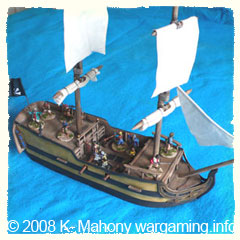
Avast! Get ye grog and hornpipe smartly, lubbers, for a beauty she will be and we must Jolly the Roger! Aye!
Kieran Mahony continues his account of building a Pirate Ship to the plans by Gary Chalk (of Wargames Illustrated Magazine) from Avast! Ye Lubbers: A Pirate Ship in 28mm [Part 1].
Details Around The Deck
I added some balsa strips around the door and also made it look like there are steps between the different deck levels. I extended some of the strips up to the main deck to make a handrail…
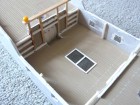
…for this I used wood from a coffee stirrer, as it’s a lot stronger than balsa wood. I also added a couple of drawing pin heads to the top of the handrail.
The Front Bulkheads
This followed the same design as the main bulkhead. Underneath the balsa is some more decking plasticard that I glued on to the bulkheads, and then the balsawood strips on top.
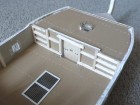
Next I filled all the edges around the ship sides and the bulkheads with lots of white filler.
Getting There
Photo 12 shows the ship so far with a rail (made from plasticard) around the outside of the boat that I decided to add. I also had to cover all the holes made by the pins I used when gluing the model together.
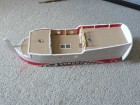
You can also see the piece of cardboard used to tidy up the bow.
Hull Details
I added the decorative parts to the front of the hull and also a handrail on the front bulkhead after some feedback from the pirate wargames yahoo group (as it looked odd without anything there).
Also I added a couple pieces of plasticard to the sides for where the rigging would be attached to the hull.
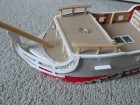
Rear Windows
The windows were created using thin strips of 0.5mm plasticard to help give more of a 3D effect. I could have also added some mesh, which would have looked good, but I didn’t have much left.
Deck Details
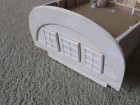
I added a ships wheel from Eureka and some brass tubing at the rear for a flag pole. This means I can insert different flags depending on who’s sailing the ship. I also added a piece of brass tubing on each side of the hull for a swivel gun, which can be removed. Also visible is the quarter windows made from a piece of balsa and some thin 0.5mm strips of plasticard.
Adding The Masts
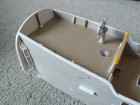
I brought some 4, 6 and 8mm dowel from the local hardware store and cut it up as per the article. When I inserted it into the holes in the hull, I found it was slightly off centre so to compensate I wrapped masking tape around the bottom and near where the mast comes out of the hull. Next I drilled holes for all the joins and sanded the cross pieces so they would fit more snugly against the main masts. Also I sanded the ends into a point as recommended in the article.
Assembling The Masts
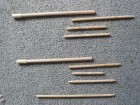
I glued the masts together with PVA and threaded a thin piece of wire through the hole on both pieces and wrapped it around the two sections as per the photos. The wire should help to make it stronger and more durable and it looks like thick rope once painted.
I also got an eyehook and cut a piece off to turn it into a normal hook and screwed it into the foremast. This is so I can detach the front sail from the masts and then take out all the masts for storage purposes.
The Sails
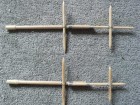
These were made from cloth I got from the local fabric shop very cheaply ($2.50 for 1 meter). I think it’s called calico and it’s pretty close to the colour I wanted so I don’t have to bother painting it. I was planning to soak the masts in watered down PVA but I was getting low on PVA so I sprayed them with a clearcoat varnish.
I used wire to support the front sail and made a little hook to loop onto the main sail. I added some lower sails to mine (The article didn’t and mentioned that they get in the way of the figures) but decided to make them rolled up. [Eds Note: This looks good, as this would be normal practice when clearing for action, age of sail ships never normally entered any action with their lower sails unfurled, etc.]
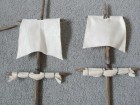
Construction Finished
Photo 19 is the model before I start painting it. It’s a lot larger than I was originally planning and the masts are very tall, but they look good. I didn’t glue the sails on until after it is painted as I was sure to get paint on them. The only other thing to do is to glue some magnetic basing material to the bottom of it so it doesn’t slide around in my box.
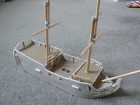
Painted Ship
I gave it a black undercoat and then dry brushed it with various shades of brown (mostly Folk Art paints). The gold highlights were done with GW shining gold as it is quite a bright gold colour. The main and swivel guns are from Eureka but at the moment I only have 3 main guns. The flag was printed out onto paper and then varnished to make it stronger.
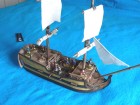
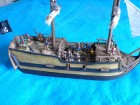
With Crew
Two shots of the finished model with some Foundry and Dixon crew…
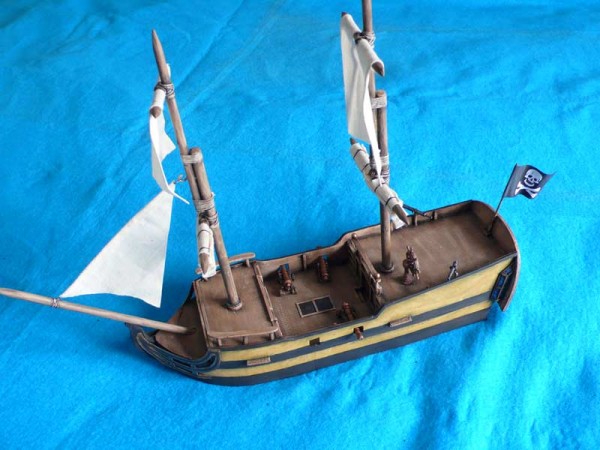
The following are the original Gary Chalk PDF’s previously available on the Wargames Foundry Website – they are supplied here as a community service and are subject to whatever original copyright and similar rights Gary Chalk & Wargames Foundry hold on them:
- Wargames Foundry Gary Chalk Pirate Ship Article Part 1 (PDF)
- Wargames Foundry Gary Chalk Pirate Ship Article Part 2 (PDF)
- Wargames Foundry Gary Chalk Pirate Ship Plan Template (PDF)
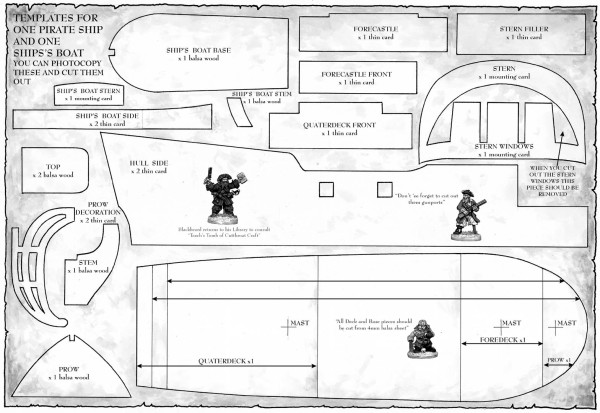
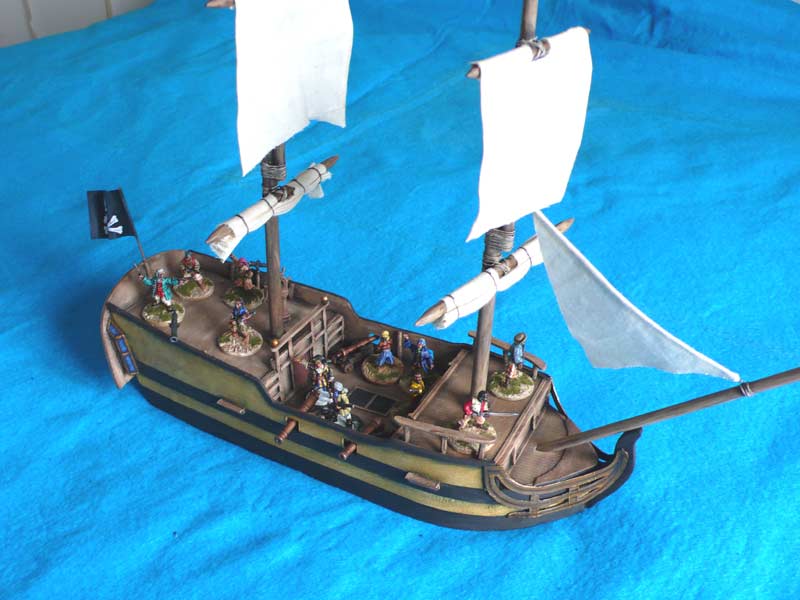
Hey, so… what size is are the plans? A4? Or 2 x 4?
Ahhh, 2 x A4 / US letter.